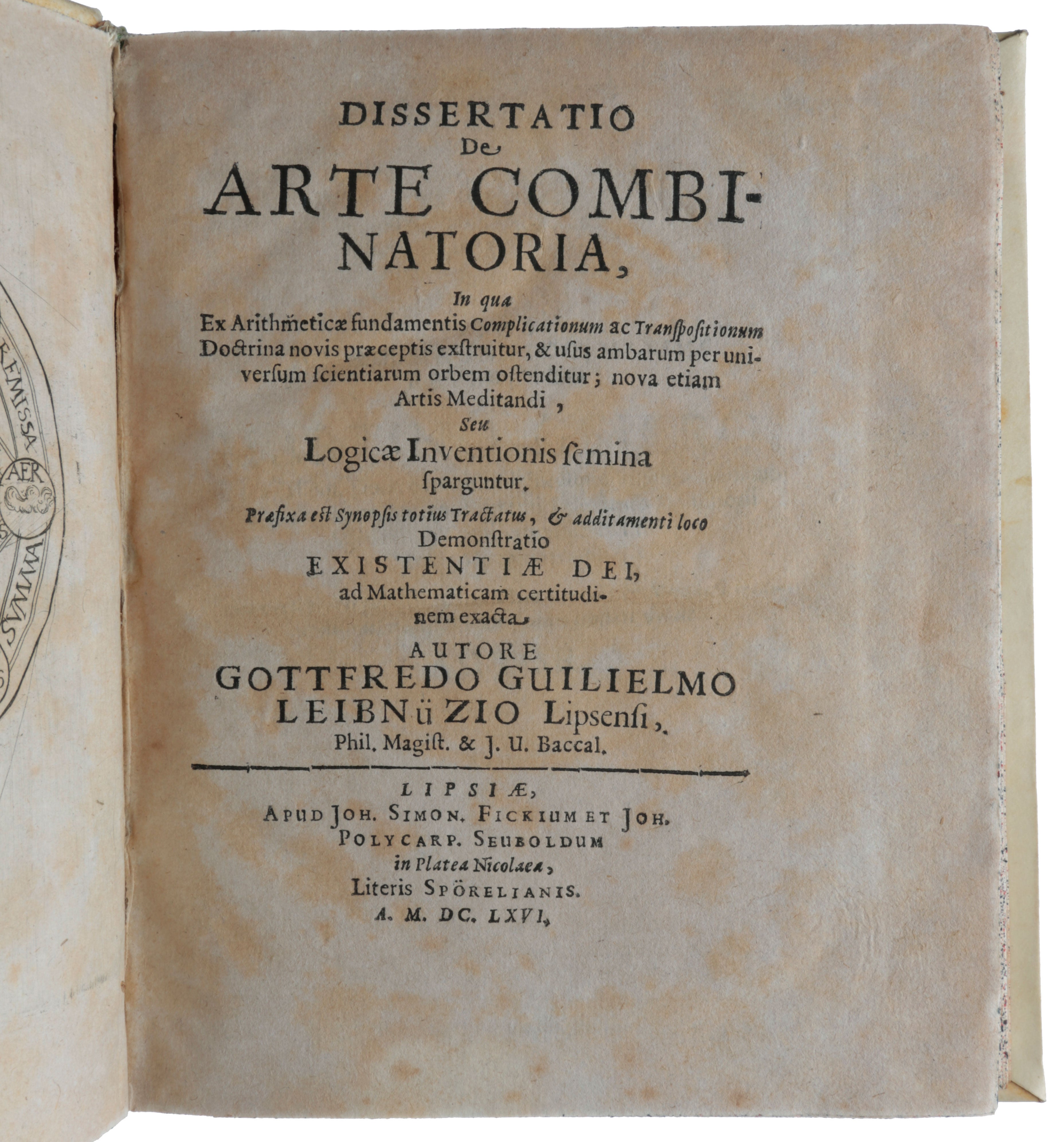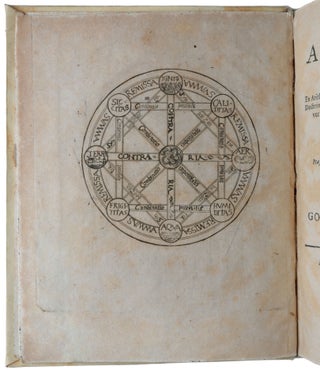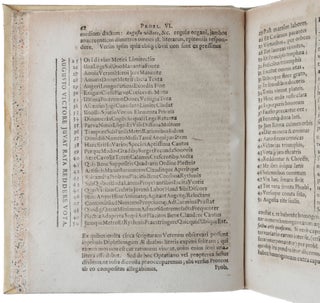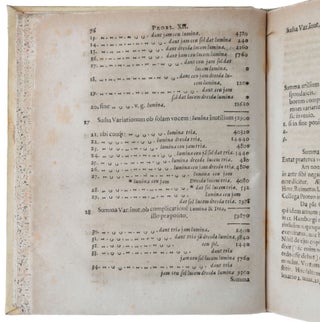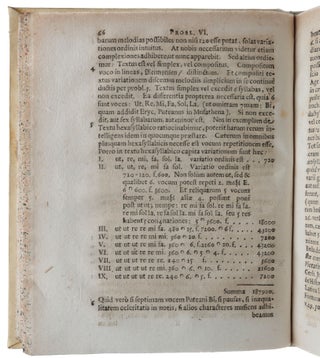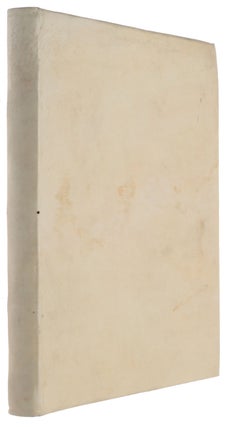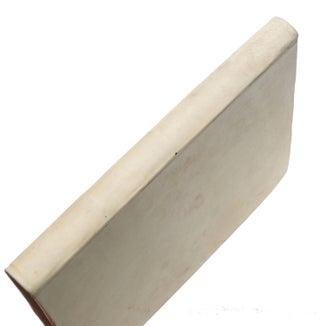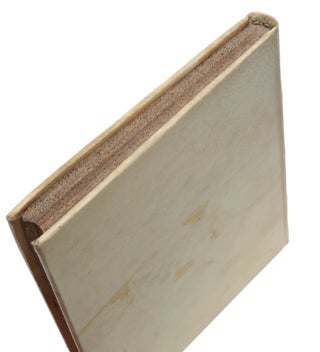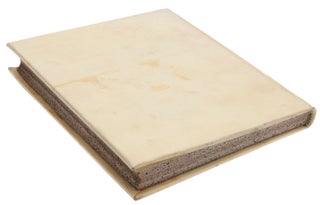Dissertatio De Arte Combinatoria, In qua Ex Arithmeticae fundamentis Complicationum ac Transpositionum Doctrina novis praeceptis extruitur & usus ambarum per universum scientiarum orbem ostenditur; nova etiam Artis Meditandi, Seu Logicae Inventionis semina sparguntur. Praefixa est Synopsis totius Tractatus, & additamenti loco Demonstratio Existentiae Dei ad Mathematicam certitudinem exacta.
Leipzig: S. Spörl for J. S. Fick & J. P. Seubold [Universitäts- und Stadtbibliothek], 1666. First edition, extremely rare. “This book contains the seeds of Leibniz’s mature thought, as well as many of the mathematical ideas that he would go on to further develop after the invention of the calculus. It is in the Dissertatio, for instance, that we find the project for the construction of a logical calculus clearly expressed for the first time. The idea of encoding terms and propositions by means of numbers, later developed by Kurt Gödel, also appears in this work. In this text, furthermore, Leibniz conceives the possibility of constituting a universal language or universal characteristic, a project that he would pursue for the rest of his life” (Mugnai et al.). “Leibniz suggests that primitive concepts might be likened to primenumbers and derivative concepts to composite numbers … Leibniz’s suggestion anticipates Gödel numbering, the technique used by Kurt Gödel totreat a formal system as a mere system of signs with a specified mapping from signs tonumbers in order to mathematically study the syntax of Peano Arithmetic” (McDonough & Soysal, p. 19). Menger (p. 210) notes that, around 1930, “Gödel had already begun to concentrate on Leibniz, for whom he entertained a boundless admiration.” Gödel numbering was crucial to the proof of his incompleteness theorem (1931). “It is here [i.e., in the Dissertatio] that we first encounter his idea of an ‘alphabet of human thought’, where complex concepts are regarded as formed through combinations of simple ones, so that any concept is understood as a logical combination of elementary ones. Here too we find the crucial insight that by representing concepts by numbers, logical inferences can be captured by arithmetical operations. This subsequently led him to develop a mathematical logic that was not superseded until the work of Boole and others in the late nineteenth century” (Arthur, p. 141). “Leibniz realized already in the seventeenth century that there is some resemblance between disjunction and conjunction of concepts on the one hand and addition and multiplication of numbers on the other” (Kneale & Kneale, p. 404) – the fundamental concept of Boolean algebra. Leibniz “attempted to contrive an alphabet of thought, or characteristica universalis … Leibniz regarded his great invention of the infinitesimal calculus (1675) as emerging from such researches, and the calculus led him to reflect still more intently on the properties desirable in such a characteristic” (Encyclopedia of Philosophy). “Leibniz occupies a special position in the history of computers, having largely contributed to both the birth of the infinitesimal calculus and set the basis of formal logic through binary numeration … However, Leibniz’s work had far great implications for computation, as it moved the development of formal logic further and virtually laid the foundation to coding as the ‘algebra of ideas’. Since the Dissertatio de arte combinatoria (1666), Leibniz demonstrated his interest in devising a universal language based on the simplest lexicon to express the largest, perhaps even infinite, number of statements” (Bottazzi, p. 28). Leibniz’s ‘algebra of ideas,’ in which the simplest are combined to make others more complex, necessitated a detailed study of combinatorics, to which a substantial part of the Dissertatio is devoted. However, “Leibniz considered the ‘ars combinatoria’ as a science of fundamental significance, much more extensive than the combinatorics of today” (Knobloch, p. 409).OCLC lists Harvard, Columbia and Oregon State in the US. Our copy is complete with the frontispiece, which is often lacking (e.g., in the copies at Columbia and the BNF). ABPC/RBH list only two other copies, a poor copy with numerous paper repairs in a modern binding, and the Macclesfield copy, which realised $102,710 in 2004. “In 1661 Leibniz (1646-1716) began his formal university education at the University of Leipzig. As the ‘modern’ philosophy of Descartes, Galileo, Gassendi, Hobbes and others had not made a great impact by this time in the German-speaking lands, Leibniz’s philosophical education was chiefly Scholastic in its nature, though he was also exposed to elements of Renaissance humanism … After receiving his baccalaureate from Leipzig, he continued his studies at the University of Altdorf. While there Leibniz published in 1666 the remarkably original Dissertation on the Art of Combinations (Dissertatio de arte combinatoria), a work that sketched a plan for a ‘universal characteristic’ and logical calculus, a subject that would occupy him for much of the rest of his life” (Stanford Encyclopedia of Philosophy). In the Dissertatio, Leibniz “explores what was known as the ‘art of combinations’ (or ‘combinatorial art’), a method which would enable its practitioners to generate novel ideas and inventions, as well as to analyse and decompose complex and difficult ideas into more simple elements. Describing it as the ‘mother of all inventions,’ which would lead to ‘the discovery of all things’, he sought to demonstrate the widespread applicability of this art to advance human endeavour in areas as diverse as law and logic, music and medicine, physics and politics. “Leibniz’s broader vision of the power of logical calculation was inspired by many thinkers – from the logical works of Aristotle and Ramus to Thomas Hobbes’ proposal to equate reasoning with computation. But Leibniz’s curiosity around the art of combinations per se was sparked by a group called the ‘Herborn Encyclopaedists’ through whom he became acquainted with the works of Ramon Llull, a Majorcan philosopher, logician, and mystical thinker who is thought to have died seven centuries ago, in 1316. Llull’s Ars magna (or ‘ultimate general art’) from 1308 outlines a form of analysis and argumentation based on working with different permutations of a small number of fundamental attributes. “Llull sought to create a universal tool for helping to convert people to the Christian faith through logical argumentation. He proposed eighteen fundamental general principles, accompanied by a set of definitions, rules, and figures in order to guide the process of argumentation, which is organised around different permutations of the principles. The art was to be used to generate and address questions such as ‘Is eternal goodness concordant?’, ‘What does the difference of eternal concordance consist of?’, or ‘Can goodness be great without concordance?’ … “While critical towards the details of Llull’s proposed categories and procedures, Leibniz was taken with his overarching vision of the combinatorial art. He drew two key aspirations from Llull’s work: the idea of fundamental conceptual elements, and the idea of a method through which to combine and calculate with them. The former would enable us to reformulate more complex ideas in terms of simpler ones. The latter would enable us to reason with these elements precisely and without error, as well as generate new insights and ideas. “Just as all words in a language could be represented by the comparatively small number of letters in an alphabet, so the whole world of nature and thought could be considered in terms of a number of fundamental elements – an ‘alphabet of human thought’. By reformulating arguments and ideas in terms of a characteristica universalis, or universal language, all could be rendered computable. The combinatorial art would not only facilitate such analysis, but would also provide means to compose new ideas, entities, inventions, and worlds … Ultimately he hoped that a perspicuous thought language of ‘pure’ concepts, combined with formalised processes and methods akin to those used in mathematics, would lead to the mechanisation and automation of reason itself” (Gray). “From the Dissertatio, the project for the characteristic art inherits the following, fundamental ideas: 1) An analysis of concepts is needed to reach the first, simple concepts; 2) By means of a synthetic procedure, complementary to that of analysis, all possible complex objects may be derived out of the simple ones; 3) The process of synthesis can be performed by combining the concepts, simple and complex, on the basis of the rules of logic; 4) If we assign to each simple concept a symbol of an alphabet, we may unambiguously represent in symbolic form any complex concept whatsoever; 5) Given that any elementary truth can be expressed by combining two concepts corresponding, respectively, to a subject and a predicate, the process of combining the simple concepts will generate all possible truths, constituting the basis of the art of discovery; 6) If we employ numbers to represent concepts, we may make logical inferences simply by operating on numbers, as in an arithmetical calculus, instead of operating directly on concepts” (Mugnai et al., p. 4). “Compared with the works of authors belonging to the tradition of Lullism, the Dissertatio differentiates itself first of all because of the emphasis put on the theory of syllogism, then for the attempt to extend the combinatorial calculus to any kind of matter. Finally, even though Leibniz’s mathematical training was not very developed at the time, an intense mathematical flavour that can hardly be found among the followers of Ramon Lull emanates from the Dissertatio” (ibid., p. 10). “From a modern mathematical point of view the Ars Combinatoria lends itself to the following subdivisions: “Leibniz says that he has given proofs for the solutions of only a few problems … Three things he credits to earlier authors: the determination of the number of combinations without repetition (CwoR) of two objects, of all possible CwoR, and of permutations without repetition (PwoR)” (Knobloch, p. 413). Problem 1 describes how the number of CwoR can be found. Leibniz’s method is to use the arithmetic triangle (Pascal’s triangle). He then presents eight propositions, the contents and proofs of which he asks the reader to take from the arithmetic triangle. Problem 2 determines the total number of all CwoR of n objects, giving the answer as 2n– 1. “Here we have the first hint of Leibniz’s studies on additive number theory, which has been known as ‘partitio numerorum’ since Euler” (ibid., p. 414). The most interesting application is to answer the question: ‘how many combinations of a certain size or of all possible sizes contain a certain number of given elements?’ In problem 3 Leibniz determines the number of combinations of sets (‘classes’) for a given number of sets and the elements within the sets. He defines partitions (‘discerptiones’) as subsets of combinations. Only those ‘complexiones’ are called ‘discerptiones’ which, when taken together, equal the total. Leibniz writes that it is possible to determine partitions of a certain size as well as of all sizes. Later remarks indicate that Leibniz was already experimenting with partitions of more than two summands. Beginning with problem 4, Leibniz studies permutations. He determines the number of PwoR by means of the recursion rule n! = n(n – l)! and illustrates it by presenting numerous so-called Protean rhymes, i.e., rhymes which permit an unusually large number of rearrangements of their words without violation of the metrical laws. Problem 5 is dedicated to circular permutations, the number of which he correctly determines as n!/n = (n – l)!. “The final six problems hardly seem to deal with mathematics. Nevertheless Leibniz here, too, solves a number of interesting combinatorial questions which have previously been overlooked. Problem 7 considers permutations that contain a ‘caput’, i.e., a subset that is mapped onto itself by the permutation, or, in a special case, remains invariant. He distinguishes six possible types of ‘caput’ by its having one or several elements, by the presence or absence of homogenous elements (which can be placed in a given position in the same way as those already placed), and whether or not it is monadic (possessing no homogenous elements) … “In problem 8 he determines the number of permutations which have several ‘capita’ in common. Problem 9 then precisely states the conditions under which this is not possible: firstly, when several ‘capita’ partly or completely take the same place in a permutation, and, secondly, when the same (monadic) element occurs within several capita. The final three problems deal with the cases in which permutations or ‘capita’ are useful or useless, a question which still received some passing attention in Bernoulli’s Ars Conjectandi (1713). This is not a purely mathematical decision, but has to be made in cooperation with the sciences from which each special case has been taken (e.g., origin of elements calls on natural science, and transposition of rhymes requires metrics)” (ibid., pp. 415-416). In the Dissertatio, Leibniz conceived his “characteristica universalis, a discipline separate from the actual act of calculating (calculus ratiocinator), which he imagined to become more and more a mechanized activity. This separation was essential for both the development of more sophisticated logical thinking and for the actual development of the architecture of the modern computer. The basis of the characteristica should have been rooted in real phenomena, but the power of this type of thinking made immediately evident that ‘new realities’ could have also been calculated and logically inferred through mathematical operations. This brilliant observation not only laid the foundations for computation but also opened up the possibility to generate new numerical combinations. This intuition promised to invest machines (proto-computers, in fact) with the potential to augment our cognitive capabilities and imagine different cultural and even social realities; a promise that still seems [only] partially fulfilled today … “The task of expressing thoughts through algebraic notation proved more complicated than expected as Leibniz realized that the problem was twofold: on the one hand, to map out all the domains to be simulated by defining their characteristics; on the other, to detect with univocal precision the primitives of such language. The task of naming such primitives was replaced by the idea of postulating them instead to concentrate all the efforts on the syntax of the logic to compute them. The result was used by Leibniz to describe with mathematical – algebraic, quantitative – precision qualitative phenomena: the characteristica allowed running calculations, obtaining exact results, based on symbols whose meaning cannot be clearly and distinctively identified. The clear separation between describing a problem through logic and calculating it is still an essential characteristic of how computers operate” (Bottazzi, pp. 28-29). “Jonathan Swift’s satirical classic Gulliver’s Travels (1726) parodied the mechanical conception of invention advanced by Llull and Leibniz. In the fictional city of Lagado, the protagonist encounters a device known as ‘the engine’, which is intended by its inventor to enable anyone to ‘write books in philosophy, poetry, politics, laws, mathematics, and theology, without the least assistance from genius or study’ … The mechanical, combinatorial approach to cultural creation that Swift treated as an absurd caricature became a productive experimental technique for later writers, artists, and musicians – from the permutational works of American composer John Cage, to the generative poetic experiments of the French literary group Oulipo, to more recent procedural approaches of digital and software art. Moreover, the mechanization and externalization of reasoning processes exhibited by machine learning technologies and algorithms has not only become socially and culturally productive, but economically lucrative for today’s silicon empires … “The initial trickles of Llull’s and Leibniz’s arcane combinatorial fantasies have gradually given way to ubiquitous computational technologies, practices, and ideals which are interwoven into the fabric of our worlds – the broader consequences of which are still unfolding around us. The objects of their embryonic faith have become the living a priori of the digital age – providing the conditions of possibility for our experience and our reflection, our genres of deliberation, our forms of sociality, and our institutions of judgement – regardless of whether or not the machines operate in the ways that we imagine” (Gray). In 1690 the Frankfurt book dealer Cröker published an unauthorized reprint of the dissertation, to which Leibniz reacted in the February issue of the Acta Eruditorum. The text of the Dissertatio was reproduced by Gerhardt in volume IV of his edition of Die philosophische Schriften von Gottfried Wilhelm Leibniz (Berlin, 1880). The first English translation was published in 2020. Leibniz’s work is here bound with four other dissertations: VD 17 547:667972E; Ravier 6; Cantor III, 43 ff. Arthur, Review of Mugnai et al., infra, The Leibniz Review 30 (2020), pp. 141-145. Bottazzi, Digital Architecture Beyond Computers, 2018. Gray, ‘‘Let us Calculate!’ Leibniz, Llull and the computational imagination’ (https://publicdomainreview.org/essay/let-us-calculate-leibniz-llull-and-the-computational-imagination). Kneale & Kneale, The Development of Logic, 1984. Knobloch, ‘The mathematical studies of G.W. Leibniz on combinatorics,’ Historia Mathematica 1 (1974), pp. 409-430. McDonough & Soysal, ‘Leibniz’s formal theory of contingency’, History of Philosophy & Logical Analysis 21 (2018), pp. 17-43. Menger, Reminiscences of the Vienna Circle and the Mathematical Colloquium, 1994. Mugnai, van Ruler & Wilson, Leibniz: Dissertation on Combinatorial Art, 2020.
4to (195 x 165mm), pp. [viii, including engraved frontispiece], 78, [1, errata] (light browning and foxing). Later vellum.
Item #5799
Price: $185,000.00

